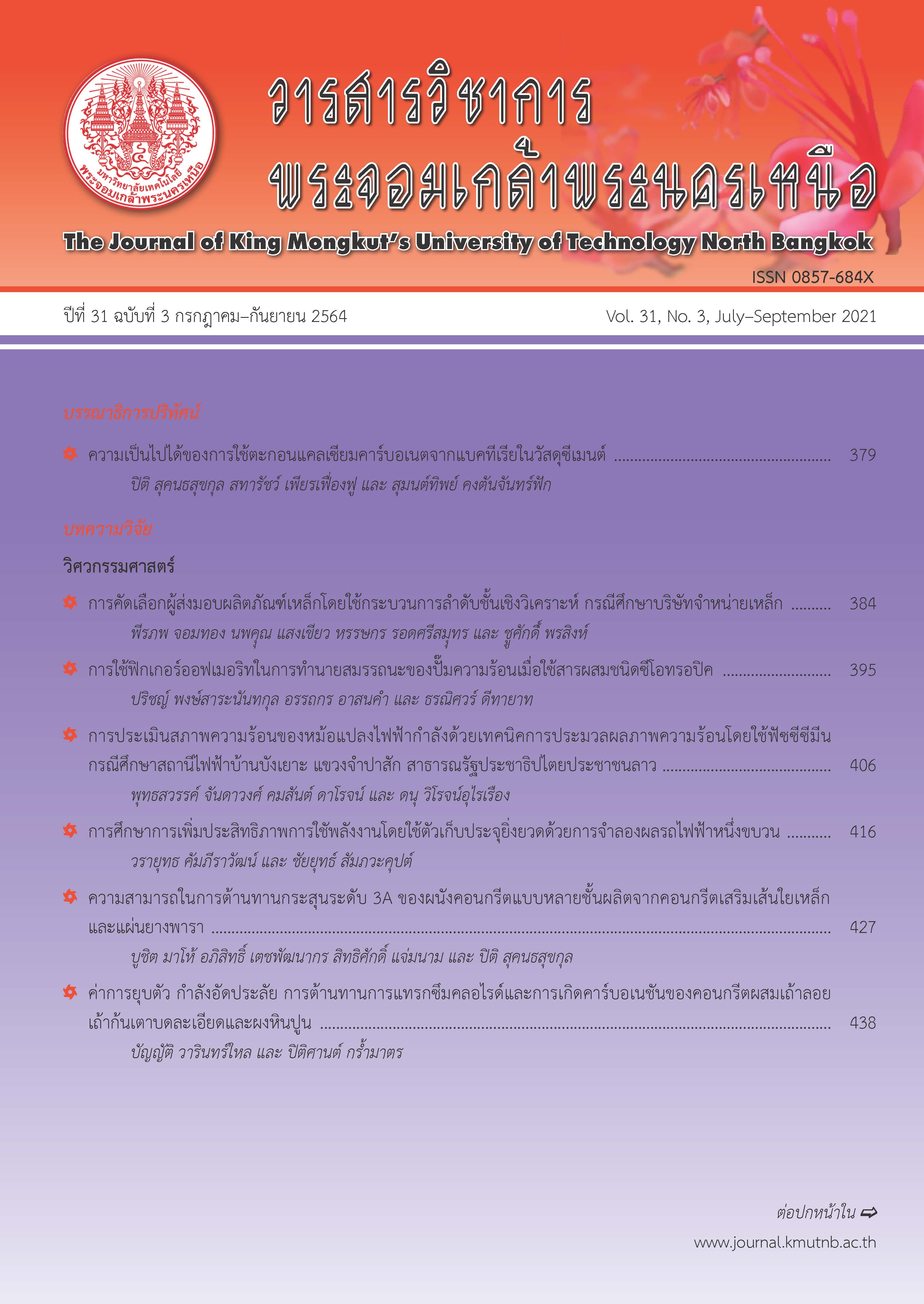ค่าการยุบตัว กำลังอัดประลัย การต้านทานการแทรกซึมคลอไรด์และการเกิดคาร์บอเนชันของคอนกรีตผสมเถ้าลอย เถ้าก้นเตาบดละเอียดและผงหินปูน
Main Article Content
บทคัดย่อ
งานวิจัยนี้มุ่งศึกษาค่าการยุบตัว กำลังอัดประลัย ความต้านทานการแทรกซึมคลอไรด์และการเกิดคาร์บอเนชั่นของคอนกรีตผสมเถ้าลอย เถ้าก้นเตาบดละเอียด และผงหินปูน ในปูนซีเมนต์ปอร์ตแลนด์ประเภทที่ 1 (OPC) จากผลการศึกษาพบว่า ค่าการยุบตัวของคอนกรีตผสมเถ้าลอยมีค่ามากกว่าของ OPC ล้วน ในขณะที่ค่าการยุบตัวของคอนกรีตผสมเถ้าก้นเตาบดละเอียดและผงหินปูนมีค่าน้อยกว่า กำลังอัดประลัยของคอนกรีตผสมเถ้าลอย คอนกรีตผสมเถ้าก้นเตาบดละเอียดมีค่าน้อยกว่าของ OPC ล้วนที่อายุ 28 วัน ส่วนกำลังอัดประลัยของคอนกรีตผสมผงหินปูนมีค่าใกล้เคียงกับของ OPC ล้วน นอกจากนี้คอนกรีตผสมเถ้าลอย คอนกรีตผสมเถ้าก้นเตาบดละเอียด และคอนกรีตผสมผงหินปูน มีความสามารถต้านทานการแทรกซึมคลอไรด์ดีกว่า OPC ล้วน ในขณะที่ความต้านทานการแทรกซึมคลอไรด์ของคอนกรีตที่แช่น้ำ 91 วันมีค่ามากกว่าของคอนกรีตที่แช่น้ำ 28 วัน สุดท้ายพบว่าการเกิดคาร์บอเนชั่นของคอนกรีตผสมผงหินปูนมีค่าใกล้เคียงหรือสูงกว่าไม่มาก ขณะที่คอนกรีตผสมเถ้าก้นเตาบดละเอียด และผสมเถ้าก้นเตาบดละเอียดร่วมกับผงหินปูนมีค่าสูงกว่า เมื่อเปรียบเทียบกับ OPC ล้วน
Article Details
บทความที่ลงตีพิมพ์เป็นข้อคิดเห็นของผู้เขียนเท่านั้น
ผู้เขียนจะต้องเป็นผู้รับผิดชอบต่อผลทางกฎหมายใดๆ ที่อาจเกิดขึ้นจากบทความนั้น
เอกสารอ้างอิง
[2] K. Charoenprom and W. Chalee, “Chloride penetration depth in concrete under marine exposure,” The Journal of KMUTNB, vol. 21, no. 3, pp. 257–266, 2011 (in Thai).
[3] S.K.Roy, K.B.Poh, and D.O.Northwood, “Durability of concrete accelerated carbonation and weathering studies,” Building and Environment, vol. 34, no. 5, pp. 597–606, 1998.
[4] J. Khunthongkeaw, S. Tangtermsirikul, and T. Leelawat, “A study on carbonation depth prediction for fly ash concrete,” Construction and Building Materials, vol. 20, no. 9, pp. 744–753, 2006.
[5] C. D. Atis, “Accelerated carbonation and testing of concrete made with fly ash,” Construction and Building Materials, vol. 17, no. 3, pp. 147–152, 2003.
[6] N.I. Fattuhi, “Carbonation of concrete as affected by mix constituents and initial water curing period,” Materiaux et Constructions, vol. 19, pp. 131–136, 1986.
[7] B. Warinlai and P. krammart, “Basic properties and carbonation of concrete replaced with different binders,” SWU Engineering Journal, vol. 13, no. 1, pp. 27–38, 2017 (in Thai).
[8] Standard Test Method for Fineness of Hydraulic Cement by Air Permeability Apparatus, ASTM C 204–00, 2000.
[9] Standard Test Method for Density of Hydraulic Cement, ASTM C 188–95, 1995.
[10] Standard Test Method for Slump of Hydraulic-Cement Concrete, ASTM C 143/C 143M–98, 1998.
[11] Part 108. Method of Making Test Cube from Fresh Concrete, BS 1881, 1983.
[12] Standard Test Method for Electrical Indication of Concrete's Ability to Resist Chloride Ion Penetration, ASTM C 1202–97, 1998.
[13] Standard Test Method for Compressive Strength of Hydraulic Cement Mortars (Using 2-in. or [50-mm] Cube Specimens) 1, ASTM C 109–07, 2007.
[14] Standard Practice for Petrographic Examination of Hardened Concrete, ASTM C 856–04, 2004.
[15] K. Tuntisukrarom, T. Choksawangnetr, P. Srihabutra, and R. Cheerarot, “Utilization of ground bottom ash in high performance concrete,” Research and Development Journal, vol. 23, no. 1, pp. 40–47, 2012 (in Thai).
[16] S. Rukzon and P. Chindaprasirt, “Strength and carbonation model of rice husk ash cement mortar with different fineness,” Journal of Materials in Civil Engineering, vol. 22, no. 3, pp. 253–259, 2010.
[17] S. K. Roy, D. O. Northwood, and K. B. Poh, “Effect of plastering on the carbonation of a 19-year-old reinforced concrete building,” Construction and Building Materials, vol.10, no. 4, pp. 267–272, 1996.
[18] L.J. Parrott, A Review of Carbonation in Reinforced Concrete. British: Cement Association, 1987.

